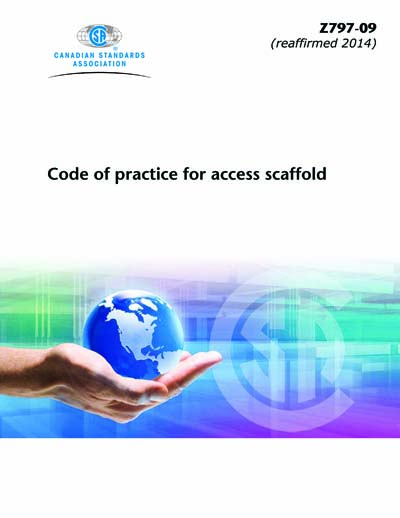Historical
CSA Z797-2009 (R2014)
Z797-09 (R2014) - Code of practice for access scaffold
Preface
This is the first edition of CSA Z797, Code of practice for access scaffold. The purpose of this Standard is to provide criteria for the safe erection (in this Standard, this term includes assembling, altering, and dismantling) and use of the various types of scaffold.Scope
1. Scope This Standard applies to the erection and use of access scaffold that is(a) supported on a surface;(b) hung from multiple points, but is not capable of moving vertically or horizontally; or(c) mounted on wheels. This Standard addresses key hazards, including fall hazards, structural instability, platform failures, and material handling problems. Note: In this Standard, the term erection refers to the assembling, altering, or dismantling of a scaffold.1.2 Purpose The purpose of this Standard is to provide criteria for the erection, use, and inspection of scaffold and for the training of erectors and users of such equipment to prevent personal injuries and accidents.
1.3 Equipment not covered This Standard does not apply to the following equipment: (a) falsework for construction purposes, as covered in CSA S269.1; (b) formwork, as covered in CAN/CSA-S269.3; (c) suspended access equipment, as covered in CAN/CSA-Z91 and CAN/CSA-Z271; (d) mechanical elevating work platforms, as covered in CAN/CSA-B354.1, CAN/CSA-B354.2, and CAN/CSA-B354.4; (e) manual or powered mast-climbing work platforms, such as a pump jack scaffold or equipment covered in CAN/CSA-B354.5; and (f) centre-pole scaffolds.
1.4 Terminology In this Standard, shall is used to express a requirement, i.e., a provision that the user is obliged to satisfy in order to comply with the standard; should is used to express a recommendation or that which is advised but not required; may is used to express an option or that which is permissible within the limits of the standard; and can is used to express possibility or capability. Notes accompanying clauses do not include requirements or alternative requirements; the purpose of a note accompanying a clause is to separate from the text explanatory or informative material. Notes to tables and figures are considered part of the table or figure and may be written as requirements. Legends to equations and figures are considered requirements. Annexes are designated normative (mandatory) or informative (non-mandatory) to define their application.
1.5 Measurement The values given in SI (metric) units are the standard. The values given in parentheses are for information only.
CSA America, Inc. [csa]

